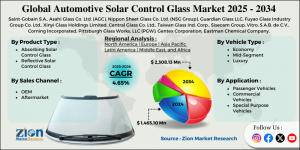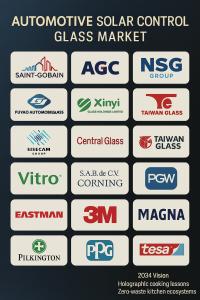Automotive Solar Control Glass Market Size Forecast: $1.47B in 2024 to $2.31B by 2034, at 4.65% CAGR
Automotive solar control glass market was valued at approximately USD 1,465.10 million in 2024 and is expected to reach around USD 2,308.13 million by 2034
The global automotive solar control glass market was valued at approximately USD 1,465.10 million in 2024 and is expected to reach around USD 2,308.13 million by 2034. (CAGR) of 4.65%”
PUNE, MAHARASHTRA, INDIA, July 25, 2025 /EINPresswire.com/ -- The global automotive solar control glass market is poised for steady growth in the coming decade, driven by a heightened focus on energy efficiency, passenger comfort, and evolving regulatory standards in the automotive industry. Valued at approximately USD 1,465.10 million in 2024, the market is projected to reach USD 2,308.13 million by 2034, expanding at a compound annual growth rate (CAGR) of 4.65% between 2025 and 2034.— Deepak Rupnar
Access key findings and insights from our Report in this sample -https://www.zionmarketresearch.com/sample/automotive-solar-control-glass-market
Solar control glass, designed to reduce heat and ultraviolet (UV) radiation from entering vehicles while maintaining visibility, is becoming an increasingly important feature in modern vehicles, particularly in electric vehicles (EVs), premium models, and SUVs.
Automotive Solar Control Glass Market: Overview
Automotive solar control glass is specialized glazing designed to reduce heat transmission, block harmful UV radiation, and manage light penetration into vehicle interiors while maintaining visibility and structural integrity for enhanced passenger comfort and efficiency. These products offer thermal management, UV protection, glare reduction, privacy, and customization.
Products range from basic tinted glass with minimal solar control to multi-layered glazing systems with metallic coatings, ceramic nanoparticles, and specialized interlayers to perform across different climates and vehicle types.
The growing consumer preference for stringent fuel efficiency, emissions regulations, and technological advancements in glass manufacturing are expected to drive growth in the global automotive solar control glass industry.
Key Insights:
As per the analysis shared by our research analyst, the global automotive solar control glass market is estimated to grow annually at a CAGR of around 4.65% over the forecast period (2025-2034)
In terms of revenue, the global automotive solar control glass market size was valued at around USD 1,465.10 million in 2024 and is projected to reach USD 2,308.13 million by 2034.
The automotive solar control glass market is projected to grow significantly due to rising consumer demand for vehicle comfort features, increasing electric vehicle adoption necessitating energy-efficient components, advancements in glass manufacturing technology, and raising awareness of UV radiation protection for vehicle occupants.
Based on product type, absorbing solar control glass leads the segment and will continue to lead the global market.
Based on application, passenger vehicles are expected to lead the market.
Based on vehicle type, mid-segment vehicles are anticipated to command the largest market share.
Based on sales channel, OEM is expected to lead the market during the forecast period.
Based on region, Asia Pacific is projected to lead the global market during the forecast period.
If you have any special requirements, Request customization: https://www.zionmarketresearch.com/custom/9483
Automotive Solar Control Glass Market: Competitive Analysis
The global automotive solar control glass market is led by players like:
Saint-Gobain S.A.
Asahi Glass Co. Ltd. (AGC)
Nippon Sheet Glass Co. Ltd. (NSG Group)
Guardian Glass LLC
Fuyao Glass Industry Group Co. Ltd.
Xinyi Glass Holdings Limited
Central Glass Co. Ltd.
Taiwan Glass Ind. Corp.
Sisecam Group
Vitro
S.A.B. de C.V.
Corning Incorporated
Pittsburgh Glass Works
LLC (PGW)
Gentex Corporation
Eastman Chemical Company
3M Company
Magna International Inc.
Sekisui Chemical Co. Ltd.
Pilkington Group Limited
PPG Industries Inc.
TESA SE.
Key Market Drivers
1. Increasing Demand for Cabin Comfort and UV Protection
Consumers are placing a greater emphasis on thermal comfort, glare reduction, and UV shielding in vehicles. Solar control glass significantly lowers interior temperatures, reduces reliance on air conditioning, and protects passengers and interiors from sun damage—especially in hot and sunny regions. This not only enhances passenger experience but also contributes to fuel efficiency and battery preservation in EVs.
2. Focus on Fuel Efficiency and Emissions Reduction
By reducing the load on air conditioning systems, solar control glass can contribute to lower fuel consumption and improved vehicle energy efficiency. In hybrid and electric vehicles, reduced air conditioning demand helps extend driving range, making solar control technologies an important addition in sustainable mobility.
3. Rise in Electric and Luxury Vehicle Adoption
The growing popularity of electric vehicles (EVs) and luxury cars, which often come equipped with advanced glazing technologies, is boosting the demand for solar control glass. These segments prioritize comfort, technology integration, and energy conservation, all of which align with the benefits offered by solar control glazing.
4. Stringent Automotive Glazing Regulations
Governments and regulatory bodies across the globe are implementing stricter rules regarding vehicle emissions, safety, and occupant protection. Automotive OEMs are incorporating solar control glass to meet these standards while maintaining performance, visibility, and passenger safety.
Automotive Solar Control Glass Market: Segmentation
The global automotive solar control glass market is segmented into product, application, vehicle, sales channel, and region.
Based on product type, the market is segregated into absorbing solar control glass and reflective solar control glass. Absorbing solar control glass leads the market due to its cost-effectiveness and ease of integration with existing manufacturing processes.
Based on application, the automotive solar control glass industry is classified into passenger, commercial, and special purpose vehicles. Of these, passenger vehicles hold the largest market share due to higher production volumes, stronger consumer demand for comfort features, and greater willingness to pay for premium glass options in this segment.
Based on vehicle type, the automotive solar control glass market is divided into economy, mid-segment, and luxury vehicles. Mid-segment vehicles are expected to lead the market during the forecast period as they represent the optimal balance between price sensitivity and feature adoption.
Based on sales channels, the market is segmented into OEM and aftermarket. The OEM segment leads the market due to integration advantages, quality assurance, warranty considerations, and the trend toward factory-installed premium features across expanding vehicle segments.
Regional Outlook
North America: Strong adoption of high-tech features and a growing EV market, particularly in the U.S., support steady demand for solar control glass.
Europe: Leading the way in environmental regulations and luxury vehicle production, making it a key region for solar control glass integration.
Asia-Pacific: The fastest-growing market, led by China, India, Japan, and South Korea, where increasing vehicle production and consumer comfort awareness are driving growth.
Latin America and Middle East & Africa: These emerging regions offer significant potential due to hot climates and increasing vehicle penetration.
Purchase Full Report : https://www.zionmarketresearch.com/buynow/su/automotive-solar-control-glass-market
Challenges in the Market
High manufacturing and integration costs for advanced solar control glass may limit its adoption in entry-level and mid-segment vehicles.
Complexity of material technologies, including coatings and laminated layers, requires sophisticated supply chains and quality control.
Aftermarket awareness and availability remain limited in some developing regions.
However, as manufacturing processes improve and economies of scale are achieved, costs are expected to decline, expanding market accessibility.
Future Trends and Opportunities
Smart Glass Technologies: Integration of electrochromic and photochromic features that adjust tint levels based on light intensity or user control.
Advanced Coatings: Development of multi-functional coatings that offer UV protection, thermal insulation, and self-cleaning properties.
Automated and Autonomous Vehicles: Greater use of panoramic glass and innovative materials for aesthetic and functional purposes.
Sustainability: Increased use of recyclable and energy-efficient glazing materials, aligning with global green vehicle goals.
More Trending Reports by Zion Market Research -
Solar PV Panels Market
Coated Glass Market
Deepak Rupnar
Zion Market Research
+1 855-465-4651
richard@zionmarketresearch.com
Visit us on social media:
LinkedIn
Instagram
Facebook
YouTube
X
Legal Disclaimer:
EIN Presswire provides this news content "as is" without warranty of any kind. We do not accept any responsibility or liability for the accuracy, content, images, videos, licenses, completeness, legality, or reliability of the information contained in this article. If you have any complaints or copyright issues related to this article, kindly contact the author above.



